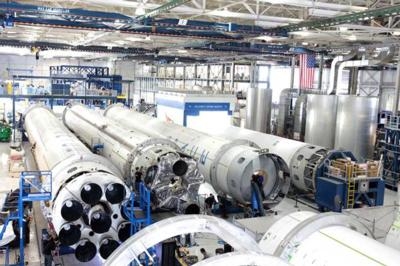Thu, Sep 26, 2013
Manufacture Of Falcon 9 Booster Also Growing
With its claim of being the only operational vehicle capable of taking significant amounts of cargo both to and from the International Space Station, SpaceX’s Dragon spacecraft is already a critical piece of the American space program. With at least 10 more station resupply missions over the next couple years, and with development of a human-rated Dragon and DragonLab underway, production of the Dragon spacecraft has increased significantly. No other American company is mass producing spacecraft at the same rate.

In addition to being a hub of Dragon activity, SpaceX has also increased production on its upgraded Falcon 9 vehicle. In an article posted on its website, SpaceX says that more than 70% of each Falcon launch vehicle is manufactured or assembled at the SpaceX Hawthorne production facility, which allows SpaceX to avoid the pitfalls associated with single-source parts dependency and gives the company competitive advantages in quality, cost and schedule control.
Ease of manufacturing is inherent in the Falcon 9 design. Each Falcon 9 is identical, regardless of the type of mission it will fly—from low Earth orbit to geosynchronous transfer orbit to resupply of the International Space Station. Commonalities in the vehicle’s subassemblies also facilitate rapid production. For instance, the second-stage tanks of the Falcon 9 are a shorter version of the first-stage tanks and use most of the same tooling, material and manufacturing techniques. The second-stage engine is a modified, vacuum version of the engine used to power the first stage. The fuel tanks feature a common bulkhead design for the liquid oxygen and rocket-grade kerosene. Falcon 9’s propellant tank walls and domes are both made from an aluminum-lithium alloy.
To accommodate a high production rate, the facility’s manufacturing footprint has more than doubled to almost 1 million sq ft. SpaceX produces more rocket engines than any other U.S. manufacturer and the SpaceX factory is one of the largest manufacturing facilities in California—large enough to fit two complete Falcon 9’s end to end along the short length of the building. With a floor plan designed around mass production, the factory is already set up to eventually achieve a pace of forty cores annually.
(Images provided by SpaceX)

More News
Airport Marking Aids Markings used on runway and taxiway surfaces to identify a specific runway, a runway threshold, a centerline, a hold line, etc. A runway should be marked in ac>[...]
"It is extremely difficult, if not impossible, for manned aircraft to see a drone while conducting crop-enhancing and other aerial applications at low altitudes and high speeds. We>[...]
Aero Linx: The Skyhawk Association The Skyhawk Association is a non-profit organization founded by former Skyhawk Pilots which is open to anyone with an affinity for the A-4 Skyhaw>[...]
“The T-54A benefits from an active Beechcraft King Air assembly line in Wichita, Kansas, where all required METS avionics and interior modifications are installed on the line>[...]
Aero Linx: Aerostar Owners Association The Association offers the Aerostar Owner a unique opportunity to tap an invaluable source of information concerning the care and feeding of >[...]
 ANN's Daily Aero-Term (04.28.24): Airport Marking Aids
ANN's Daily Aero-Term (04.28.24): Airport Marking Aids Aero-News: Quote of the Day (04.28.24)
Aero-News: Quote of the Day (04.28.24) ANN's Daily Aero-Linx (04.28.24)
ANN's Daily Aero-Linx (04.28.24) Aero-News: Quote of the Day (04.29.24)
Aero-News: Quote of the Day (04.29.24) ANN's Daily Aero-Linx (04.29.24)
ANN's Daily Aero-Linx (04.29.24)




